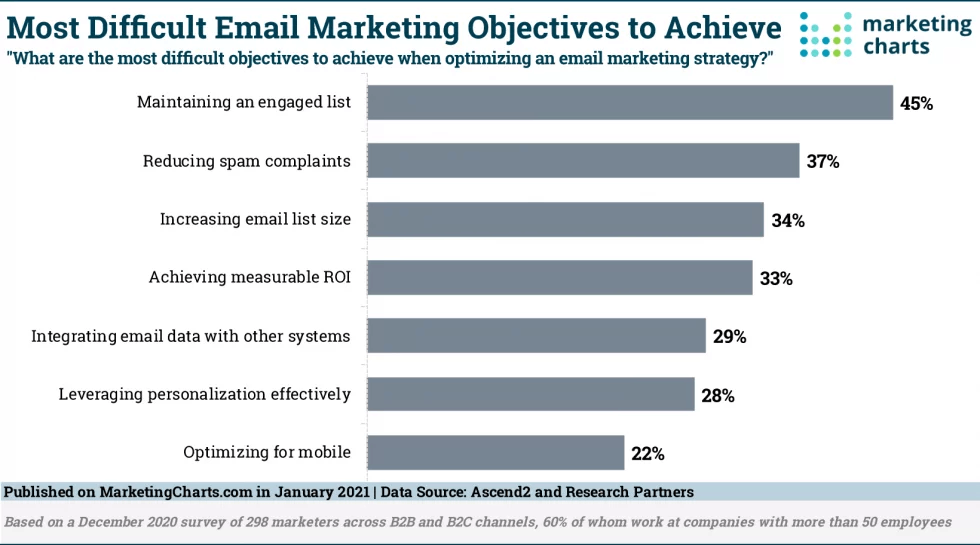Keeping Lists Engaged Proves A Challenge

Email has a proven track record of driving sales — even more so than other popular online channels. And, it looks like marketers are showing no sign of stepping back from using this effective channel in the near future, with close to three-quarters of the almost 300 marketers surveyed [download page] by Ascend2 and its research partners saying they expect to increase the volume of sent email campaigns significantly (36%) or moderately (38%) in the year ahead.
Read the full article to find out how to keep your list engaged and active.
See you on the action-field,
Raksha Sukhia, SMB Growth Expert,
Founder BBR Network. #bbrnetwork

Email has a proven track record of driving sales — even more so than other popular online channels. And, it looks like marketers are showing no sign of stepping back from using this effective channel in the near future, with close to three-quarters of the almost 300 marketers surveyed [download page] by Ascend2 and its research partners saying they expect to increase the volume of sent email campaigns significantly (36%) or moderately (38%) in the year ahead.
Even though email is considered effective, marketers have run into some challenges when trying to optimize their email marketing strategy. For almost half (45%) of respondents, maintaining engagement with email subscribers is considered one of the most challenging of email marketing strategy objectives. This may prove even more of an obstacle as there is often an inverse correlation between volume and engagement.
Marketers have been using automation to aid their efforts in email engagement for some time now. Ascend2’s research found that marketers cite automated series such as welcome/thank you (49%) and survey/feedback (46%) as two of the most effective for email engagement. Re-engagement (32%), remarketing (31%) and personal events (30%) are considered among the most effective by fewer marketers surveyed.
Separately, an earlier study from SparkPost and Survey Monkey shows that, when it comes to post-purchase emails, consumers are more likely to engage with emails that offer information on special deals and discounts, requests to review products and tips for using the product or service purchased.
Along with maintaining an engaged subscriber list, marketers responding to this latest survey also say they are finding it difficult to achieve objectives such as reducing spam complaints (37%), increasing email list size (34%), and achieving measurable ROI (33%). Only about 1 in 5 (22%) say they find it difficult to optimize for mobile.
Improvements Leading to Effective Optimization
With personalization leading to an array of benefits including improved loyalty, revenue and retention, it makes sense that more than two-fifths (43%) of marketers believe that personalization is one of the most important characteristics to improve for effective optimization.
Data quality often goes hand-in-hand with personalization, but it is sometimes a hindrance if marketers are not able to access reliable data. As such, 39% of respondents listed data quality as a characteristic they are prioritizing for improvement, while others feel it is important to improve email design (34%), messaging (33%) and types of content (28%).
Testing and Inactivity
Although there was an uptick in the share of marketers who used A/B testing for email in 2019, another study from Ascend2 last year found that very few marketers believe they could improve email with more testing.
That said, this more recent research found that when performing pre-deployment testing on emails, respondents say they test design (43%), deliverability (36%) and subject lines (35%) the most. About one-third (32%) also run subscriber verification testing.
In addition to testing emails, marketers must consider what to do with their inactive subscribers and when it is appropriate to remove them from their email list. The majority of those surveyed say a subscriber should be inactive for at least 2 months before removing them from an email marketing list, with 25% saying they wait more than 1 year before removing inactive subscribers.
The full report can be found here.
About the Data: Results are based on a December 2020 survey of 298 marketers across B2B and B2C channels, 60% of whom work at companies with more than 50 employees.
Related Article
What’s a Good Landing Page Conversion Rate?
Business Agility Is the New Norm. Do You Have What It Takes?
Tags
#BBR Network, #LinkedIn #Social Media Marketing, #Profitability, #Small Business Growth, #Small Business Marketing and Sales, #SMB, #SME, B2B, Build Business Results, Build Business Results (BBR), Build Business Results (BBR) Mastermind.










